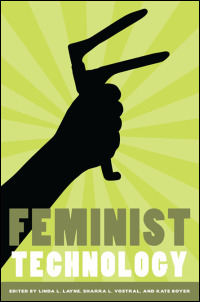 During the fall 2010 semester, students in my graduate course on Gender, Science, Technology, and Medicine read Feminist Technology. One of their assignments was to generate a blog entry of their own. Here is one of the products they evaluated. —Linda Layne, co-editor of Feminist Technology
During the fall 2010 semester, students in my graduate course on Gender, Science, Technology, and Medicine read Feminist Technology. One of their assignments was to generate a blog entry of their own. Here is one of the products they evaluated. —Linda Layne, co-editor of Feminist Technology
*****
I stumbled across the Property Leash security system while searching the web for feminist technologies. I found the website Market Launcher, which tries to connect inventors with investors. Under the section “Women’s Products (including for children)” I found the ad for “The Property Leash.” I thought that his would be good candidate for feminist technology since it was developed with women in mind. The product was developed by a man whose mother had had her purse snatched when he was young.
The leash is meant to protect by thwarting bump and grab attack and would also prevent women from accidentally walking away from their purses. The goal is to bring attention to the purse snatcher so that others can come to her aid. It is not intended for use when alone or at night when it might become dangerous for the woman to remain attached to her bag while her assailant struggles to take it.
While primarily conceived of as a solution to the problem of purse snatching, the creator suggests that the product has a wide demographic due to the large concern for maintaining personal property including in addition to purses, book bags and briefcases. The creator sees a role for this product at restaurants, summer festivals and concerts but focuses on the high risk of purse snatching at casinos, the intended introductory market. The strap allows the user to attach it to her leg or arm and prevent the attack.
What I couldn’t get out of my head was the image of a potential purse-snatcher jerking and pulling on the purse in full public view and the potential for injury that could result. Catching a belt loop or loose clothing can be painful enough if only propelled by the person’s own careless force. Imagine the injury potential when a person is forcefully pulling and jerking on the property leash. Granted, the creator notes this danger as a problem at night, but is it merely limited to that? The underlying assumption of the Property Leash is that the world is dangerous and that it is better to attach a nylon cord to the purse in order to hang onto it rather than letting the item go. At what point does the property become more important than the person attached to it?
Furthermore, it may serve only to reinforce fears of theft in the public world. How can you forget that you might be in the presence of those who seek to victimize you when a strap constantly reminds you that you are secured to your own purse? It also suggests an even stronger connection between women and their purses. Rather than just being associated, they are physically connected. The purse, in a sense, is now an attached part of the woman’s body. Perhaps it has the picture of the handcuffed briefcase that protects nuclear secrets or other valuables in mind, but creates a gendered product in order to approximate that object. Although it mentions that this product might also be useful to men and children, it ignores the differences about what men and women are expected to carry with them that might require a leash. It claims to be a product that is designed to protect robberies and theft of ID, but men typically keep their IDs and money in wallets. Chain wallets have had various amount of success. So if men were using the property leash, it is much more likely it would be an occasional use, not something that was carried with them every day.
In essence, the inventor does not seem to be thinking about the real circumstances in which women and men find themselves. While it has a useful goal, it is unlikely that it provides the peace of mind that it claims, and in fact, may produce more harm than help. It does raise the interesting question of why women are expected to carry purses. Perhaps, like high heels, they are intended to encumber women, restricting their freedom by making movement more difficult?
